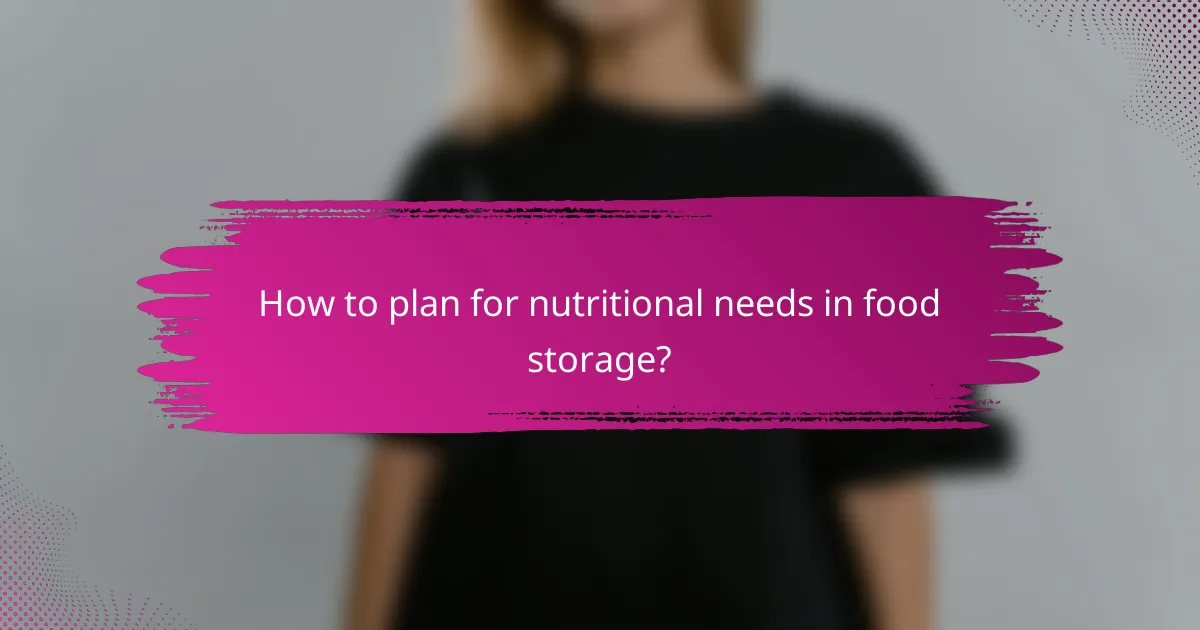Effective food storage is crucial for meeting the nutritional needs of families, as it involves careful planning and organization of food inventory. By ensuring a balanced selection of food items that provide essential nutrients, families can promote health and prevent deficiencies. Additionally, proper food storage practices help maintain the nutritional quality of food while minimizing waste, ultimately supporting overall well-being.

How to plan for nutritional needs in food storage?
Planning for nutritional needs in food storage involves understanding dietary requirements, organizing food inventory, and setting guidelines for storage duration. By taking these steps, families can ensure they have balanced meals that support health over time.
Assess dietary requirements
Start by evaluating the nutritional needs of all family members, considering factors like age, gender, activity level, and any specific health conditions. This assessment helps determine the essential food groups and nutrients required for a balanced diet.
For example, children may need more calcium and iron, while adults might focus on fiber and protein. Use resources like dietary guidelines or consult a nutritionist to tailor your food storage plan accordingly.
Establish a food inventory
Create a comprehensive inventory of the foods you currently have on hand. This should include categories such as grains, proteins, fruits, vegetables, and dairy products. Keeping an updated list helps identify gaps in nutritional needs and prevents over-purchasing.
Consider using a spreadsheet or a dedicated app to track expiration dates and quantities. Regularly review and adjust your inventory to align with your family’s dietary requirements.
Set storage duration guidelines
Establish clear guidelines for how long different food items can be stored while maintaining their nutritional value. Generally, dry goods can last several months to years, while fresh produce and dairy have shorter shelf lives.
Label containers with purchase dates and recommended usage timelines. This practice helps avoid waste and ensures that you consume foods before they spoil, maintaining a balanced diet.
Utilize meal planning tools
Incorporate meal planning tools to streamline your food storage strategy. Use apps or calendars to plan meals based on your inventory and dietary needs, ensuring a variety of nutrients are included throughout the week.
Meal planning can also help you utilize perishable items before they expire, reducing food waste and supporting family health. Aim for a mix of proteins, grains, and vegetables in each meal for balanced nutrition.
Incorporate seasonal foods
Incorporating seasonal foods into your storage plan can enhance nutrition and reduce costs. Seasonal produce is often fresher, tastier, and more affordable, making it a great choice for family meals.
Research local farmers’ markets or grocery store sales to find in-season items. This not only supports local agriculture but also allows for a diverse diet that changes with the seasons, promoting overall health.

What are the key components of balanced food storage?
Balanced food storage involves ensuring a variety of food items that provide essential macronutrients, vitamins, and minerals while also considering hydration. Proper planning can help maintain family health by preventing nutritional deficiencies and promoting overall well-being.
Macronutrient balance
Macronutrient balance refers to the appropriate proportions of carbohydrates, proteins, and fats in your food storage. Aim for a mix that includes whole grains, lean proteins, and healthy fats to support energy levels and bodily functions.
For example, consider storing items like brown rice, canned beans, and nuts. A general guideline is to allocate about 50-60% of your food storage to carbohydrates, 15-25% to proteins, and 20-30% to fats. This balance can help ensure that meals are satisfying and nutritionally complete.
Incorporating vitamins and minerals
Incorporating vitamins and minerals into your food storage is crucial for maintaining health. Focus on a variety of fruits and vegetables, whether fresh, frozen, or canned, to provide essential nutrients like vitamin C, potassium, and iron.
Consider storing items such as canned tomatoes, leafy greens, and fortified cereals. A diverse selection helps cover a broader range of nutritional needs, reducing the risk of deficiencies. Aim for colorful options, as different colors often indicate different nutrients.
Hydration considerations
Hydration is a vital aspect of balanced food storage, as water is essential for nearly all bodily functions. Ensure you have a sufficient supply of clean drinking water, which can be stored in bottles or large containers.
In addition to water, consider including hydrating foods like fruits and vegetables, such as cucumbers and watermelon. Aiming for about 2-3 liters of water per person per day is a good benchmark, but individual needs may vary based on activity levels and climate conditions.

How can families maintain health through food storage?
Families can maintain health through effective food storage by planning meals, balancing nutrition, and ensuring food safety. Proper food storage not only minimizes waste but also preserves the nutritional quality of food, contributing to overall family health.
Preventing food waste
Preventing food waste is crucial for both health and budget management. Families should regularly check their pantry and refrigerator to use older items first and plan meals around what they already have. A good practice is to create a meal plan that incorporates perishable items to ensure they are consumed before spoiling.
Additionally, consider freezing surplus food or leftovers to extend their shelf life. Label containers with dates to keep track of freshness, and aim to use frozen items within a few months for optimal taste and nutrition.
Ensuring food safety
Ensuring food safety is essential to prevent foodborne illnesses. Families should store food at appropriate temperatures, keeping refrigerators below 4°C (40°F) and freezers at -18°C (0°F). Regularly checking the temperature settings can help maintain safety standards.
It’s also important to practice proper food handling techniques, such as washing hands before preparing food and using separate cutting boards for raw meats and vegetables. Following expiration dates and discarding any expired items promptly can further enhance food safety.
Engaging children in food preparation
Engaging children in food preparation can foster healthy eating habits and teach them about nutrition. Involve them in simple tasks like washing vegetables, measuring ingredients, or stirring mixtures. This not only makes cooking fun but also helps them understand the importance of balanced meals.
Consider creating a family cooking night where everyone participates in preparing a meal together. This can be a great opportunity to discuss the nutritional value of different foods and encourage children to try new ingredients, promoting a positive relationship with healthy eating.

What criteria should be used for selecting food storage solutions?
When selecting food storage solutions, consider factors such as the type of food, storage duration, and environmental conditions. Effective storage should maintain food quality, prevent spoilage, and ensure safety for family health.
Assessing storage conditions
Assessing storage conditions involves evaluating temperature, humidity, and light exposure. Ideal storage conditions typically include a cool, dry, and dark environment to prolong shelf life and maintain nutritional value.
For example, canned goods thrive in temperatures between 10-21°C (50-70°F), while grains and cereals should be stored in a dry place with low humidity to prevent mold and pests. Regularly check these conditions to ensure they remain optimal.
Evaluating container options
Choosing the right containers is crucial for effective food storage. Options include glass jars, plastic bins, vacuum-sealed bags, and metal containers, each with its advantages and disadvantages.
Glass jars are excellent for long-term storage due to their airtight seal and non-reactive nature, while vacuum-sealed bags can significantly reduce oxygen exposure, extending shelf life. Ensure containers are food-safe and suitable for the specific items being stored.

What are the best practices for long-term food storage?
Best practices for long-term food storage involve proper techniques to preserve food quality and safety over time. Key methods include maintaining appropriate temperatures, using airtight containers, and regularly checking for spoilage.
Vacuum sealing techniques
Vacuum sealing is an effective method for extending the shelf life of food by removing air from packaging. This process helps prevent oxidation and the growth of bacteria, making it ideal for meats, vegetables, and dry goods.
To vacuum seal, use a vacuum sealer machine that creates an airtight seal around the food. Ensure the bags are clean and dry before sealing. For best results, store sealed items in a cool, dark place, ideally below 20°C (68°F).
Freezing vs. canning
Both freezing and canning are popular methods for preserving food, but they have distinct advantages. Freezing retains the texture and flavor of food better, while canning allows for long-term storage without the need for refrigeration.
When freezing, ensure food is properly packaged in freezer-safe containers to prevent freezer burn. For canning, follow safe canning guidelines to avoid spoilage and ensure food safety, such as using a pressure canner for low-acid foods like vegetables and meats.

